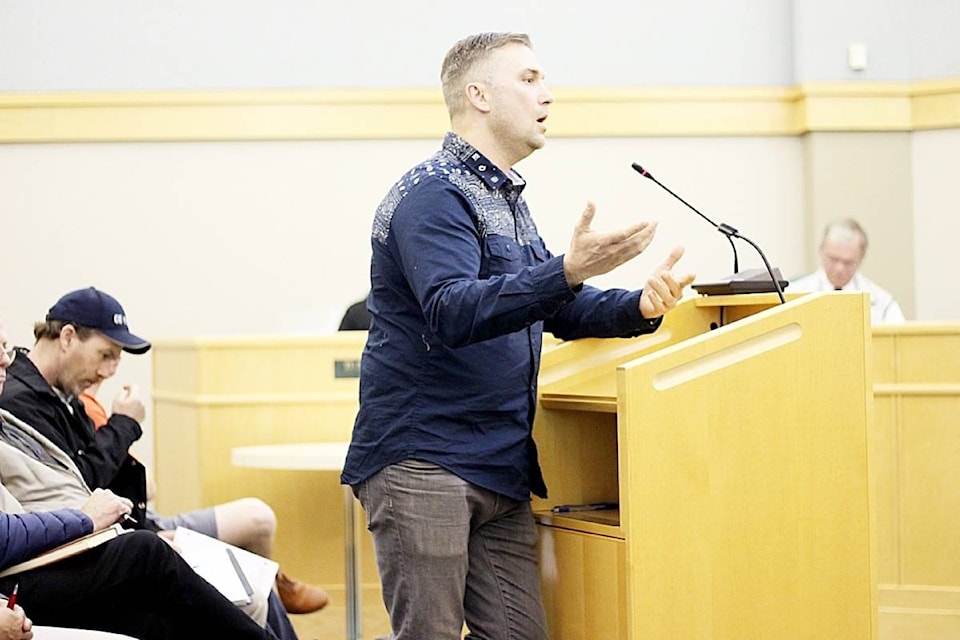Qualicum Beach town council needs to consider the rewards versus the risks when it comes to the proposed development at 560/570 Laburnum Rd., says Lance Nater.
Nater was one of more than a dozen people who got up to speak at Monday’s (April 24) public hearing on 560/570 Laburnum Rd. Comments from the gallery bounced between concern for the wetland and the lack of housing inventory.
In March, the applicant brought forward a new proposal of 22 lots, ranging in size from 500 square metres to 1,200 square metres, after Mayor Teunis Westbroek brought forward a motion in January to make the development more suitable for families.
The property would be divided into three parcels: 2.9 ha will be donated to the town for conservation purposes, 2.3 ha will be retained at Rural Residential zoning with two existing homes, and 2.4 ha will include the 22 lots which would permit up to six duplexes, with a minimum of four duplexes required, said planning director Luke Sales.
“A covenant would be registered on the titles so that if a developer does not build a duplex on one of the remaining two lots, a $10,000-contribution would be paid toward the town’s affordable housing fund,” Sales said.
The contentious development proposal has been on the agenda at council a handful of times over the last year. In October 2016, the project was moved to first reading as a 10-unit residential development, with two larger lots for existing homes, a wetland area to be donated to the town for conservation purposes and a park area with a 10-metre green buffer adjacent to Laburnum Road. This was after council shot down the 60-unit development and the second application for 30 units.
Nater said the rewards for the project would be providing housing and getting some security over the Sensitive Ecosystem Inventory (SEI) polygon wetland, while the risks would be what is done to the water table and the question of whether council will actually be satisfying any need for family housing.
The agenda package included a geotechnical assessment carried out by Lewkowich Engineering Associates Ltd. (LEA) for the developer. Nater pointed out that part of the report discussed permanent dewatering on the property.
The report states, “Given the shallow, substantial nature of the groundwater condition encountered during the test pitting, LEA recommends the installation of site dewatering measures prior to any excavation works or general construction activity. The installation of meausres to lower and subsequently control groundwater within the site is critical to the ‘safe and suitable’ nature of the development. If the following measures are installed either partially or incorrectly, the comments, recommendations, and conclusions made in this report are void.”
Nater said this suggested to him that this was sensitive land and “not just a hayfield.”
This development, said Nater, is a balancing act for council between the environment and housing.
“Council has more of a responsibility than just providing housing... You don’t have the power to create family housing, and it’s almost a disservice to wrap a project around that terminology unless you can control pricing because pricing determines whether families are going to be able to afford,” said Nater, referring to earlier comments made by Jared Shaw who is part of the local tech industry.
Shaw, who said he was speaking on behalf of families, said this discussion has been dragged out, which is just going to cost the developer more money. That, in turn, will affect the people wanting to buy the lots, he said.
“We need to build some family homes. We need to do it now,” Shaw said. “When I hear things over debate on whether or not this is a wetland or not; how long have you had to study this land to figure that out? Why is this still a debate? Why is it murky?”
Shaw said sometimes the environment and social-human impact might not be equal.
“Sometimes you’ve got to make a decision. It might not be the perfect one, but you’ve got to make a decision. You’ve got to do it for your community.”
Scott Harrison, who also got up to speak from the overflowing gallery, said both sides are right and have a fundamental point.
“St. Augustine of Hippo once said, ‘‘Lord, grant me chastity, but not just yet.’ It seems tonight we’re talking about ‘Lord, grant me family housing, but not just yet,’” Harrison said.
Harrison said there are external pressures on the local housing market being driven by anyone who wants to retire to Qualicum Beach as it’s an ideal retirement community, adding that when housing stock becomes available there is going to be fierce competition.
“As of (Monday) morning, there are precisely three rooms available as a single-occupant rental suite. That’s less than 0.1 per cent of the accommodations,” Harrison said of the more than 4,000 residences in town.
Although questions to council aren’t allowed in public hearings, Harrison asked council why it doesn’t work in conjunction with a service organization to ensure that low-income seniors or young families are housed in these buildings.
